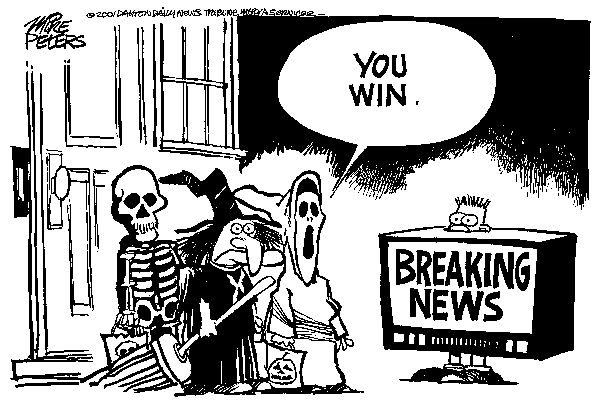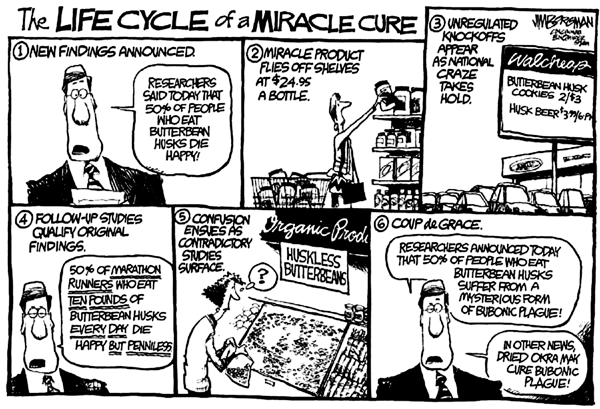
Food Insight - Managing the Risks of Eating - Printable version
Healthy living requires understanding food risks and maintaining good eating and physical activity habits. This often becomes challenging, particularly during busy times and holidays. For many people, Halloween kicks off an intense holiday season - at least when it comes to eating. A night of kids begging for candy from everyone, despite strict orders from parents not to ever accept candy from strangers the rest of the year, often leads to serious overloading on candy by delighted and happy kids and adults. Then comes Thanksgiving, the annual holiday for which food IS the theme. And so on, with many holiday parties occurring until we find ourselves on New Year’s Day facing the bathroom scale and reflecting on the gluttony.
Scared by the latest
news about food and nutrition? Get perspective!
 © 2003 Mike Peters. Reprinted with permission from
Grimmy, Inc. All rights reserved.
© 2003 Mike Peters. Reprinted with permission from
Grimmy, Inc. All rights reserved.
Not surprisingly, food (including beverages) and food risks emerge as prominent topics of discussion during the holidays. Consumers also remain chronically overwhelmed by so much information about food and nutrition – much of it scarier than any Halloween costume and in direct conflict with our desires to thoroughly enjoy food. While no one questions that eating comes with risks, putting the risks of eating into perspective presents a challenge. This guide offers 10 simple actions and insights to help you keep food and the risks of eating in perspective.
10 Actions (PDF)
Eating provides many benefits. Consider that:
- Foods supply calories that your body needs as a source of energy.
- Foods help your body function normally by providing some essential nutrients that the body cannot make and must get from dietary sources, including some vitamins, minerals, amino acids, and fatty acids.
- Individual foods vary in the amounts of different nutrients, protein, carbohydrates, and fats that they contain, so variety in your diet is not only fun and exciting it is required. Back to 10 Actions
2. Recognize eating-related
risks
Every activity in life comes with some risks - including eating. With the enormous benefits and necessity of eating well-recognized many people forget about the relatively low but very real risks of food poisoning, choking, and allergic reactions. In the overall scheme of things, eating poses relatively low risks and not eating for a prolonged period of time poses a much greater risk, but eating related-risks are not zero:
| 100% | chance of dying from starvation if you stop eating completely |
| 0.1% | approximate average annual chance of going to a hospital due to food poisoning |
| 0.002% | approximate average annual chance of dying from food poisoning |
| 0.0001% | approximate average annual chance of dying from choking on food |
3. Actively
reduce your eating-related risks
Many opportunities exist to reduce your eating-related risks. Make sure to:
- Eat slowly and chew food well to prevent choking and improve your chances of a good outcome by knowing how to respond to a choking emergency
- Get tested if you suspect you may have a food allergy, and if you are allergic to any foods carefully check food ingredients and preparations to avoid problems and carry any medications that you might need
- Reduce food poisoning risks from bacteria, viruses, and parasites by selecting foods carefully, appropriately handling and cleaning fresh foods, thoroughly cooking poultry, meats, fish, and seafood, and properly refrigerating and storing foods
- Pay attention to food recalls and consume foods before their expiration dates
- Wash your hands thoroughly before handling food and eating, after using the bathroom, and frequently during the day
- Choose places that you can trust that require employees to practice good hygiene when eating away from home Back to 10 Actions
4. Exercise and count calories
Excess body fat currently represents a public health crisis.
Overweight and obese people experience increased risks of many diseases,
including heart disease, diabetes, some cancers, and sleep problems when
compared to people of normal body weights. Fat accumulates when your body
gets more calories than it needs, so you need to get your energy balance
right and make sure that you burn off any excess calories that you consume.
If you need to lose weight, then you need to burn more calories than you
take in over time while still making sure that you consume the daily nutrition
that your body needs. As a general rule, make sure to get an hour of moderate
to vigorous exercise at least 4 times per week and at least a little exercise
everyday.
Back to 10 Actions
5. Read, understand, and use
food labels
Getting information from food labels can help you make better
food choices. Start at the top so that you know the serving size
and the number of servings in the package, then look at the total number
of calories and the calories from fat. Although dietary needs differ,
in general most Americans need to watch and limit the total amount of
fats, cholesterol, and sodium that they consume, and make sure that they
consume enough dietary fiber and their recommended
daily intakes of essential nutrients. Make
your calories count more by preferring nutrient-rich foods within
and among all of the food groups, including a balance of fruits, vegetables,
whole grains, low-fat dairy products, and lean meats. Remember that the
percent daily values on food
labels are based on at 2,000 calorie diet, so if you need a different
number of calories you will need to make appropriate adjustments.
Back to 10 Actions
The work of putting your diet together to build
your daily food pyramid falls to you. Food labels provide
standardized information to make it easier for you to follow dietary
guidelines, which provide recommendations about the amounts of various
types of foods that you should eat. However, since you make your own food
choices, balancing your diet and making sure that you get the nutrition
your body needs is up to you. Remember that the overall pattern is what
really counts. You can make up for indulging or not exercising on one
day by eating less and exercising more on another day. So, go ahead and
enjoy your surf and turf followed by a hot fudge sundae one night, or
whatever turns you on, but make sure that you balance any indulgences
out. Unfortunately, many people consume excess calories and still get
insufficient nutrition, so pay
attention to the vitamins, elements, and macronutrients you need and
make all your calories count toward a balanced and healthy diet. People
with some diseases, including the 5.5% Americans with diabetes, need to
pay particular attention to getting the balance right.
Back to 10 Actions
7. Actively monitor your health
You should collect data and monitor your own health. Health
care providers monitor growth and development for children as they grow,
and risk factors like body mass index (BMI) for adults. Use a BMI
calculator to find your BMI and talk with your doctor if your BMI
exceeds 25. Your doctor should periodically check your blood and body
for signs and symptoms of disease and you should take advantage of screening
tests for cancers and other diseases. A good diet and staying active are
important parts of a healthy lifestyle, so pay attention to your body's
warning signals. Remember that your genes and the other choices you make
matter too, including important decisions about getting enough sleep,
not smoking, preventing injuries, drinking alcohol in moderation, and
knowing your risk factors.
Back to 10 Actions
8. Ask questions and empower
yourself
News stories frequently focus on individual foods associated
with individual diseases, but they often lack important context.
Arm yourself
with questions to ask when you encounter news stories that scare you
about any individual food. Almost any individual food can make you sick
and some could possibly kill you if you consume too much too quickly.
For example, most people need to consume more water than they currently
drink (current
recommendation of 8 cups per day). However, drinking too much water
too quickly can pose an extremely rare but deadly hazard in the form of
hyponatremia, which may occur when an athlete drinks too much water without
replacing lost salts.
Back to 10 Actions
9. Keep
individual food risks in perspective
Remember that eliminating individual foods or food groups from your diet can decrease your intake of essential nutrients and put you at risk for nutritional deficiencies. You may hear about many types of potential food hazards, including:
- Natural substances (e.g., lead, mercury, cadmium, zinc, and other metals and essential elements, which may be incorporated into plants from soil and into processed foods made from plants, and also accumulated in the food chain; botanical pesticides; many others, including some that cause some form of cancer in rodents when given large amounts - including many you may enjoy as part of a holiday meal)
- Natural toxins (e.g., numerous varieties found in poisonous mushrooms, commonly called toadstools; tetrodotoxin in Puffer fish; botulinum toxin; aflatoxin)
- Pathogens that naturally occur (e.g., Vibrio vulnificus (bacteria) or noroviruses (viruses) in some raw oysters; Salmonella in some unpasteurized milk or undercooked chicken or eggs; Cryptosporidium (parasites) in water)
- Pathogens added in processing (e.g., bacteria from cross-contamination of raw foods; Hepatitis A from infected food handlers)
- Synthetic substances (e.g., preservatives and other food additives; residues of fertilizers or pesticides; contaminants, like the melamine found in pet foods in 2007 and Chinese baby formula in 2008)
Keep in mind the complexity of diseases and that if we knew their definitive causes then we would also know the perfect cures. The risks of many diseases increase significantly with particular risk factors, including some you cannot control like age, gender, and genetics, and some that you can control like smoking, consuming excess alcohol, and other risky behaviors. Be similarly cautious about news promising miracles and carefully evaluate any health claims.
 Jim Borgman © 2001 Cincinnati Enquirer. Used by permission
of Universal Press Syndicate. All rights reserved.
Jim Borgman © 2001 Cincinnati Enquirer. Used by permission
of Universal Press Syndicate. All rights reserved.
Professionals are available to help. Talk with your
doctor, registered dieticians, and other health professionals to get the
information and advice that you need. Your risks will be different than
the risks of some of your friends and family members, so you need to understand
your opportunities to live a longer, healthier, and happier life. If you
care for others, then take the time to understand how their needs might
differ and help them make good choices about diet and physical activity
as well.
Back to 10 Actions
© 2007 Kimberly M. Thompson. For more insight and humor, check out Professor Thompson's book Risk In Perspective: Insight and Humor in the Age of Risk Management available from AtlasBooks, www.AORM.com, or Amazon.com. For more information about this guide, please contact: Dr. Kimberly M. Thompson, Harvard School of Public Health, 677 Huntington Ave., 3rd Floor, Boston, MA 02115, E-mail.